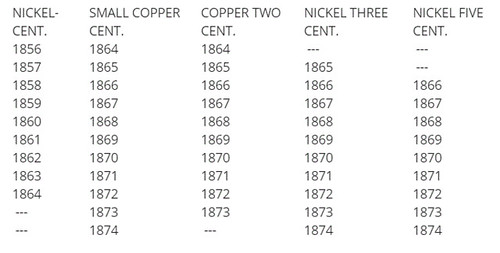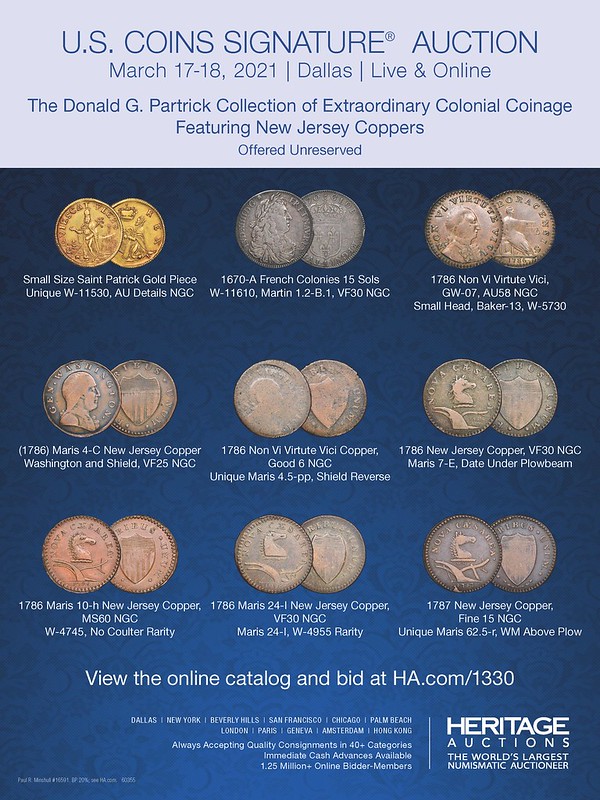
PREV ARTICLE
NEXT ARTICLE
FULL ISSUE
PREV FULL ISSUE
COLLECTING CENTS AND HALF CENTS IN 1874Gerry Tebben writes: "While researching Wiatt Bros., a Columbus, Ohio, issuer of Civil War tokens, I stumbled across this article in the March 10, 1874, issue of The Daily Dispatch about collecting U.S. cents and half cents that might interest readers. It's signed by Frank N. Bebee. I don't know anything about him (at the moment) but did notice a notice in the January 1880 issue of Numisma in which the Columbus collector is selling his complete sets of cents and half cents by the piece. "The Wiatts were an interesting family. In 1874 they and just about every other business in the city ran afoul of a temperance group. A few years later they were busted for running a crooked faro game. " Thanks! I've been helping the Newman Numismatic Portal compile a database of numismatic articles in contemporary newspapers, and we added this one. -Editor SMALL COINAGE OF THE UNITED STATES. To the Editors of The Dispatch: Thinking a short item would be of interest to many of your readers, I have undertaken to give a description of the cents and half cents of our American coinage to a limited extent. Although the tables are not exactly perfect, they are as correct as I have been able to obtain from any of the late works on numismatics. I obtain my authority for saying not correct from the works themselves. Although not perfect, they are in all probability so near it that but very few numismaticians will be able to find mistakes that will amount in the aggregate to a very great number. The remarks in regard to some of the varieties of the cents, I think, will be of interest to any person who may read this article, and am positive it will be to any one who take an interest in coins. The descriptions of the manner in which the dies are produced will, in all probability, be instructive to the majority of readers. The table of "Comparative rarity" will give a general understanding in regard to the rarity of issues, of the cents and half cents, which will answer the purpose of a collector until able to get a more perfect one. The annexed table is a compilation from Prime's Work on Coins and Dickenson's Numismatical Manual. The table of "types and varieties" will show many varieties of the cents each year. Among the most important I will mention a few: (For 1793, see table.) In 1795, there were two distinct types, one the thick planchet, (like 1794) with "one hundred for a dollar" on the edge, and a thin planchet without this inscription. In 1796, the liberty cap and fillet head. In 1800, there was one variety, in the 1800 being struck over 1799, caused by an alteration of the die in the mint from 1799 to 1800; the same of 1807 over 1806; the same of 1810 over 1809; the same of 1811 over 1810; the same of 1823 over 1822; in each the under figure (in good specimens) being very plain; in 1808, the cued hair and turbaned hair; in 1814, a crossed four and plain four; in 1817, one of the types had thirteen stars and the other fifteen; in 1839, there were four distinct types- head like the cent of 1838, silly head, booby head, and head like the cent of 1840. The silly head and booby head have each a small lock of hair falling in front of the forehead, which gives the effigy a simple expression. The rarest variety of 1843 is the one with the date directly under the bust. "The table of comparative rarity is based on only six orders. It is, of course, impossible to distinguish exactly all coins by these numbers. But the table will serve the purpose of the collector without more minute distinctions." See the complete table online. -Editor In all coin the difference between a proof, is uncirculated and circulated piece is very great. Proof coins always command a large premium, uncirculated a good premium, and circulated pieces according to their condition. Proof coins are very highly polished, and are struck from the master die before it is used for taking impressions in steel for the dies from which the coinage is produced; uncirculated pieces are from the coinage dies, and have never been in circulation; circulated pieces are those which have passed in circulation and have become worn, scratched and abused. Thinking a description of the master die or the original die cut by the engraver, would not be out of place and would be of interest, I give it as taken from Prime's Work on Coin: "This is cut in soft steel, hardened by heating and cooling in water, and then soft steel is forced into it by a tremendous pressure, thus taking an impression of it in soft steel, which is again itself hardened. Thus we have a coin in steel. This is a punch which can be forced into a dozen or a hundred dies of soft steel, which being in turn hardened, will thus produce as many dies for use in striking coins." The annexed table gives the dates of the coinage of nickel and small copper pieces, from the first year of the coinage. The 1856 nickel cent is very rare and in a table of comparative rarity would rate 6. "None but proofs were struck of the two cent pieces for 1873, and by act of Congress the issue ceased April 1st, 1873, their coinage being discontinued from that time," and, consequently, are very rare: 
I will not attempt to give a description of Colonial coins, as space will not permit. Suffice to say, that previous to the confederation and the establishment of a United States mint in 1793, the different States and Colonies each produced their own specie. Strictly speaking, the first North American coin was the New England coinage of the Massachusetts mint in 1652. The first issues of cents by the United States Government was the "Fugio" or "Franklin" cent; which was ordered by act of Congress, July 6th, 1787, and was struck by private contract. The United States coin from the established mint did not take place until 1793; when the regular issues of the cents and half cents commenced. In 1794 the first silver coins were struck from the mint. A description of the "Fugio" cent is" Obverse a sun dial, at the left the legend "Fugio," at the right "1787;" in exergue, "mind your business;" reverse, an interlocked chain of thirteen links, representing the Confederate States, a circular band within the chain and on it the legend "United States;" and in the center of this band the motto, "we are one." It is of the same size as the old copper cents. They were coined for several years but all bore the date of 1787. FRANK N. BEEBE. Articles such as these are great windows into the early state of the collecting community. I enjoyed seeing the obsolete term "numismaticians" and the reference to the "Franklin" cent, as discussed earlier this month. -Editor
To read the complete article on NNP, see:
To read the earlier E-Sylum article, see:

Wayne Homren, Editor The Numismatic Bibliomania Society is a non-profit organization promoting numismatic literature. See our web site at coinbooks.org. To submit items for publication in The E-Sylum, write to the Editor at this address: whomren@gmail.com To subscribe go to: https://my.binhost.com/lists/listinfo/esylum All Rights Reserved. NBS Home Page Contact the NBS webmaster 
|